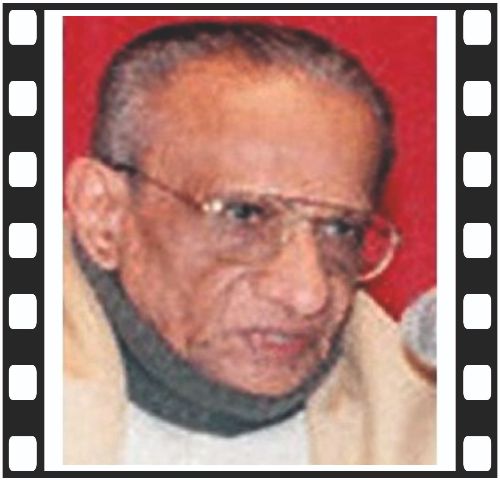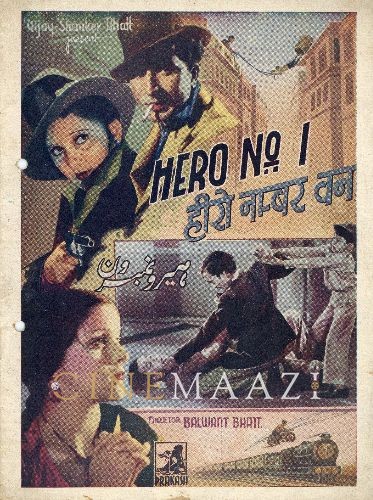Balwant Bhatt

Subscribe to read full article
This section is for paid subscribers only. Our subscription is only $37/- for one full year.
You get unlimited access to all paid section and features on the website with this subscription.
Not ready for a full subscription?
You can access this article for $2 , and have it saved to your account for one year.
- Real Name: Balwant Bhatt
- Born: 13 January 1909 (Porbandar, Gujarat)
- Died: 7 February 1965 (Bombay)
- Primary Cinema: Hindi
Balwant Bhatt was born in 1909 in the port city of Porbandar, Gujarat. He came to Bombay in the 1920s and began his career in filmmaking by assisting directors like Naval Gandhi, Pesi Karani, Ardeshir Irani, Nanubhai Vakil, Shanti Dave, etc. During the early days of his directorial career, Bhatt made action and stunt films. He and his brother Nanabhai Bhatt are believed to be the pioneers of B-grade action cinema in Bombay films. However, he also made socials and Arabian Nights fantasies later in his career. He made films in the silent era and talkies in Hindi and Gujarati. Balwant Bhatt was truly a pioneer and versatile and innovative filmmaker.
During his early days as an assistant in direction and sound recording, Balwant Bhatt worked at multiple studios like Majestic Studio, Royat Art, Imperial, and Sagar Movietone.
Bhatt made his first film Chalta Purza aka Passing Show (1932), at Royal Film Company, the predecessor to Prakash Pictures of Vijay Bhatt. He also worked as a sound recordist for Nanabhai Bhatt’s and Vijay Bhatt’s films and co-directed a couple of films with Shanti J. Dave, Alif Laila, and Gunehgaar in 1933.
Balwant Bhatt made his first talkie with Prakash Pictures, Actress (1934). Actress (1934), also known as Bambai ki Mohini, was also the first film under the banner of Prakash Pictures which proved to be a success. A social film written by the long-term writer of Balwant and Nanabhai Bhatt, Pt. Anuj. Music for Actress was given by Lallobhai Nayak, who also acted in the film alongside Miss Panna. In the 1930s and 40s, Nanabhai and Balwant Bhatt worked extensively for Vijay and Shanker Bhatt’s Prakash Pictures.
Along with his brother Nanabhai Bhatt, Balwant Bhatt became one the prominent names in B-grade action and stunt films. Films like Chalta Purza (1932), Tope ka Gola (1936), Hero No. 1 (1939), and Circus ki Sundari (aka Circus Queen, 1941) exemplify his forte of action filmmaking. His film Challenge (1937), made at Prakash Pictures, was the first animal thriller that featured a dog named Tiger and a horse named Bahadur. After the success of Challenge, Prakash went on to make other animal thrillers like Dreamland (1937) by Nanabhai Bhatt and His Highness (1946) by Balwant Bhatt.
The innovative genius of Balwant Bhatt again came to life in the film Circus ki Sundari aka Circus Queen (1941). Produced by Kikubhai Desai from Paramount, Circus Queen tells the story of a circus artist. To attain the exact atmosphere and aura of the circus, a whole circus was hired for more than a month, and no stunt doubles were used. Moti starred in the film as the circus queen. The Times of India, in Nov 1941, described the film as “a fast paced thriller of the most exciting character with plenty of comedy to make it good medicine for the blues.”
In Circuswale, a 1950 film by Balwant Bhatt, all of the early action and stunt film artists came together. Actors Fearless Nadia and John Cavas, art director and the pioneer of special effects Babubhai Mistry, written by Nanabhai Bhatt, produced by Homi Wadia, music composer Chitragutpa, and multi-talented artist Boman Shroff. This film was a colosseum of action film artists coming together under the banner of Wadia’s Basant Pictures.
Balwant Bhat was not a director of only action genres. He made socials with Prakash Pictures, such as Sansar-Lila (1935), which was made in Gujarati and Hindi, Nayi Duniya (1934), Snehlata (1936), and Poornima (1938). His other socials made outside Prakash were Shamsheerbaaz (1940), Suhaag (1940), Madhusudhan (1941), Saudagar (1942), Dillagi (1942), Aankh ki Sharam (1943), and Humari Shaan (1951). His socials offered critiques of nuanced issues. In Madhusudhan, the Don Quixote-like hero puts up a fight for various social concerns, including parents marrying their kids against their will and the customary practice of marrying young girls forcefully to rich older men. Humari Shaan deals with the problems of a middle-class joint family. In Dillagi, Balwant Bhatt made a comedy of error film where as a practical joke, a man faux calls his wife and tells her that he is dead. As he returns home, he is surprised that his wife has married another man.
Bhat made Sansar Leela (1935), Snehlata (1936), Seth Sagalsha (1947), Divadandi (1950) in Gujarati language. Snehlata was made in both Hindi and Gujarati. Seth Sagalsha is part of the mythic folklore of Gujarat. There have been many films by this name. Before Balwant Bhatt,Mohan Dayaram Bhavnani made Seth Sagalsha in 1925. Girish Manukant and Raj Charoliya made their versions in 1975 and 2020, respectively. Seth Sagalsha is the story of Karna from Mahabharata. After his death, in swargaloka (heaven), he is only offered gold and no food. The reason for this is his deeds of never donating food but gold. Upon his request, Indra gives Karna one more chance to take rebirth as Seth Sagalsha in Gujrat to donate food to people experiencing poverty. Divadandi (1950) is named after a port city in Gujarat and translates to The Lighthouse. This film is popular for its music ensemble, which included composer Ajit Merchant and Dilip Kumar and lyricists Chandravadan Mehta, ‘Befaam,’ Venibhai Purohit, and Balmukund Dave. Venibhai Purohit debuted with Devadandi and became a well-known lyricist in Gujarati cinema.
Towards the end of his filmmaking career, Balwant Bhatt made a couple of Arabian fantasy films, Hazaar Pariyan (1957) and Shahi Mehmaan (1955).
The wide-ranging styles and genres of filmmaking and his innovative prowess make Balwant Bhatt one of the pioneering and crafty filmmakers of early Indian cinema. Having worked with a few of the best filmmakers, Balwant Bhatt successfully registered his name in that pantheon through his works.
Balwant Bhatt directed many great actors of the time, including Bhagwan in action films Joker (1949), Jodidar (1950), and Nagin aur Sapera (1966); Fearless Nadia in Circuswale (1950) and Delhi Express (1949); Jayant in Chalta Purza (1932), Hero No. 1 (1939), and Snehlata (1936); Gulab in Nayi Duniya (1934), His Highness (1937), Bijli (1939), Hero No. 1, and Aankh ki Sharam (1943); Mahipal in Khoj (1953) Sardar Akhtar in His Highness (1937) and Purnima (1938). He also directed Prithviraj Kapoor in Aankh ki Sharam (1943), Johnny Walker in Shahi Mehmaan (1955), Eddie Bilimoria and John Cavas in Shamsheerbaz (1940) and Circuswale (1950), respectively. Bhatt also worked with renowned artists from other fields, such as writer Pt. Anuj, composer Chitragupta, and his brother Nanabhai Bhatt in various departments.
He also produced a few films, including his own Dillagi (1942), Nanubhai Bhatt’s Sinbad the Sailor (1952), Madame XYZ (1959), Police Detective (1960), and Teen Ustad (1961). His last film was Nagin aur Sapera (1966), featuring Bhagwan and Shammi.
Balwant Bhatt was the elder brother of Nanabhai Bhatt (father of Mahesh Bhatt, Robin Bhatt, and Mukesh Bhatt). Nanabhai Bhai initially worked as a sound recordist for Balwant Bhatt’s films, and later, he made his own films and became a renowned filmmaker. The third generation of the Bhatt family is an integral part of Bombay cinema in the present day through names such as Alia Bhatt, Rahul Bhatt, and Pooja Bhatt.
Balwant Bhatt died on 7 February 1965, leaving behind a legacy of innovative and versatile filmmaking.
References
indiancine.ma
Times of India Archives (Proquest)
Rajadhyaksha, Ashish, and Paul Willemen, eds. Encyclopedia of Indian cinema. Routledge, 2014.
Image courtesy: https://www.cinestaan.com/people/balwant-bhatt-303
-
Filmography (10)
SortRole
-

Hazaar Pariyan 1959
-

Khoj 1953
-

Circuswale 1950
-
Collegian 1944
-

Ankh Ki Sharm 1943
-

Madhu Sudan 1941
-

Hero No.1 1939
-
Culprit (Gunehgar) 1933
-










.jpg)



